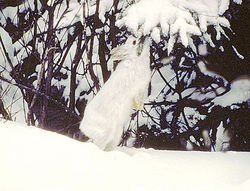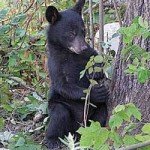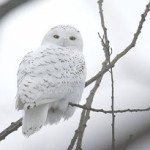By Dana Johnson

The snowshoe hare gets its name from the size of its thickly furred hind feet and its habit of spreading its toes wide when jumping. This allows the hare to travel on the top of the snow to quickly escape predators. When the hare hops or leaps, its large hind feet hit the ground in front of its fore feet leaving a characteristic track pattern. The snowshoe hare can travel at speeds of almost 30 miles per hour, and leap 10 feet in one bound. It is adept at evading predators, able to change its course quickly and also jump vertically. Even so, these hares rarely live past a year. Common predators include birds of prey, lynx, bobcat, foxes, coyotes, wolves, mink and other mustelids, and humans.
The snowshoe hare is also called the varying hare because of its seasonal fur color change. Its fur has three layers. Close to the skin is a layer soft, insulating under fur, followed by a layer of longer hairs of medium density. It is the last layer consisting of course, protective guard hairs that are shed twice a year, allowing the change of color. The process takes roughly 70 days to complete, and is triggered by the change in day length. The snowshoe hare developed this ability through adaptation in order to blend with its surroundings. When threatened the animal will often stay very still, relying on its camouflage. In winter its coat is completely white, save for its black ear tips.
The snowshoe’s diet changes with the seasons. In the summer they consume a variety of soft plants and grasses, while in winter they snip off twigs, bark, and buds from alder, aspen, birch, maple, and other trees and shrubs. As the snow gets deeper, the hares are able to eat newer plant growth from higher branches. They will also eat the youngest needles off of coniferous trees. It is a little-known fact that most herbivores will also opportunistically eat small bits of meat when protein is scarce from their typical plant diet. Snowshoe hares have an interesting digestive system that allows them to eat their food twice. First it passes through the hare as wet pellets, which are different from the dry pellets we find. These wet pellets are re-ingested to gain the rest of the nutrients, often in a place of cover where the hare feels safe.
The home range of the snowshoe hare is generally less than 15 acres and contains a network of well-maintained trails to feeding areas. Their population goes through a 10-year boom and bust cycle, and at the peak of their population there can be hundreds of hares in a square mile. There are several reasons for these population dynamics. When the population is increasing, more hares inhabit closer quarters and diseases are easily spread. Food resources get used up quickly, and predators have a smorgasbord until the population drops again.





